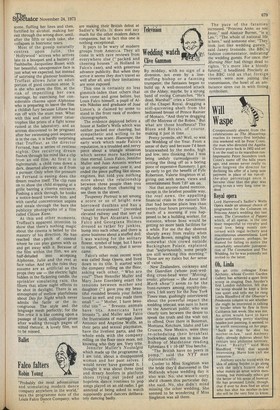Cinema
Showing how irslone .
Christopher Hudso
Truffaut's films get better and better. Day for Night (' AA' ABC) is in both senses a model of how to make a film. It opens with a shot of a subway exit in a bustling town square. Cars go past, and a coach. People gather by a newsagent's stall; a lady walks across the picture attached to a small dog on a lead. A man we recognise as the actor Jean-Pierre Leaud, emerges from the subway. The camera follows him as he walks smartly across the square. He comes up to a middle-aged .man standing outside a public building and slaps him hard across the face.
There is a cry of " Cut " and the sequence is re-run with the actors and extras taking_ their cues like clockwork animals: the lady with the dog walks a little faster; the red car slows down; Leaud delivers a more convincing slap. The cameras draw back to reveal all the paraphernalia of a film set — cables, ladders, generators, more cameras, sound equipment — and Francois Truffaut himself, who is also the director within the film. At once he is engulfed in a stream of demands and messages. A gun for the final scene has to be selected from the prop man's collection; the distribution of furniture for the right camera angle through a bedroom window has to be discussed with the photographer; the producer has to be mollified for the late arrival of the film's star from Hollywood. The examples seem arbitrarily chosen, but Truffaut wastes nothing. Each of them is used to effect later in the film.
Day for Night, in other words, is a film about people making a film, and for perhaps the first time in the history of the cinema they come across as ordinary men and women. The film they are shooting is a run-of-the-mill melodrama; as the actors arrive with their luggage of problems and idiosyncrasies, it is the story outside the story that gathers momentum. Leaud plays Alphonse, the young male lead who carries on a passionate, rather absurd affair with Liliane, a flighty creature who has been brought in as apprentice script girl to keep Alphonse happy. His father in the storyline is the actor Alexandre (Jean-Pierre Aumont) a wise and worldly actor who spends hours at the local airport waiting for his latest mistress, who turns out to be a blond, handsome boy. His wife, and Alphonse's mother, is Severine, an ageing actress who, it is rumoured( thad an affair once with Alexandre when the world and Hollywood were young. It is a scintillating performance, this, by Valentina COrtese, draping herself with momentary affection over the shoulders of old acquaintances, and, in a superb
scene, fluffing her lines and then, fortified by alcohol, making her exit through the wrong door, until. after the fifth or sixth take, she collapses in histrionic tears. Most of the gossip naturally centres upon Julie, the '
Hollywood' actress who arrives late to a bouquet and a battery of flashbulbs. Jacqueline Bisset with her beautiful, unexpressive face is just what we expected, but instead of satirising the glamour business. Truffaut allows Julie an adult portion of good common sense. It is she who saves the film, at the risk of imperilling her own marriage, by exercising her considerable charms upon Alphonse who is preparing to leave the film a childish fury because Liliane has run off with the stunt man. What with this and other minor catastrophes like prints of a fight scene ruined at the laboratory. and an actress discovered to be pregnant after her swimming-pool sequence is in the can, it is hardly surprising that Truffaut, as the director Ferrand, has a series of restless nights. One recurring dream flashes through his mind like a clip from an old film. At first it is nightmarish: a child runs down a dark, deserted alleyway, as if from a pursuer. Only when the pressure on Ferrand is easing does the dream resolve itself. The clip runs on to show the child stopping at a grille barring a cinema entrance. Pushing a stick through, he hooks a notice-board towards him, and with careful concentration unpins and steals through the bars the publicity photographs of a film called Citizen Kane.
At this and other moments. Truffaut's apparent intention to show that there's nothing magic about the cinema is belied by the mastery of his direction. He has reached that pitch of control where he can play games with us and get away with it. Because of the film within the film, we are
half-deluded into accepting Alphonse, Julie and the rest at face value. And yet the roles they assume are as artificial as the props they use — the electric light hidden in the flickering candle, the sprinkler simulating rain, the filters that allow night effects to be shot in daylight. There is an atmosphere of mellow playfulness about Day for Night which never admits the facile or the incongruous. The style and the language mesh perfectly; for the film critic it is like coming upon a passage of lucid, colloquial prose after wading through pages of stilted rhetoric. A lovely film, not t o_ be missed.,



































 Previous page
Previous page